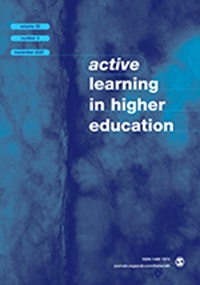Students’ perception of written, audio, video and face-to-face reflective approaches for holistic competency development
IF 3.8
1区 教育学
Q1 EDUCATION & EDUCATIONAL RESEARCH
引用次数: 6
Abstract
Reflection has been increasingly used to enhance student development in higher education, in both undergraduate and postgraduate studies. Learner autonomy is essential on reflection, particularly on how learners interpret their learning experiences. The learner has to take initiatives in making meaning of their learning by examining their experiences, and purposefully exploring their learning. Reflection is a key component in active learning as students actively engage in the process of thinking about what they have learnt or experienced. Mezirow highlighted how reflection can mean many things, including awareness of a perception, thought, feeling, intention and action, taking something into consideration or simply imagining alternatives. And there are also multiple approaches to embracing reflection today, such as reflective essays, videos and online blogs, where reflective processes and approaches may differ particularly in relation to technological adoption. In a learning environment, reflective approaches are adopted with the aim for learners to transfer knowledge and experiences to practice. However, there is scarce literature on student perception of the different reflective approaches. The present paper therefore examines student perspectives on four different reflective approaches and how these different approaches are applied within the context of higher education. The four approaches chosen are written, audio, video and face-to-face based on current literature on how reflection is documented or presented in education) and the integration of the concept of multimodality.学生对书面、音频、视频和面对面反思方法的感知,以促进整体能力发展
反思越来越多地被用于促进高等教育中的学生发展,包括本科生和研究生学习。学习者的自主性在反思中至关重要,尤其是在学习者如何解释他们的学习经历方面。学习者必须主动通过审视自己的经历和有目的地探索自己的学习,使自己的学习有意义。反思是主动学习的一个关键组成部分,因为学生积极参与思考他们所学或经历的过程。梅齐罗强调了反思可以意味着很多事情,包括对感知、思想、感觉、意图和行动的意识,考虑一些事情或只是想象替代方案。如今,也有多种方法来接受反思,如反思性文章、视频和在线博客,其中的反思过程和方法可能会有所不同,尤其是在技术采用方面。在学习环境中,采用反思性方法,目的是让学习者将知识和经验转化为实践。然而,关于学生对不同反思方法的看法的文献却很少。因此,本文考察了学生对四种不同反思方法的看法,以及这些不同方法如何在高等教育中应用。选择的四种方法是书面的、音频的、视频的和面对面的,基于当前关于如何在教育中记录或呈现反思的文献)以及多模态概念的整合。
本文章由计算机程序翻译,如有差异,请以英文原文为准。
求助全文
约1分钟内获得全文
求助全文
来源期刊

Active Learning in Higher Education
EDUCATION & EDUCATIONAL RESEARCH-
CiteScore
13.20
自引率
12.00%
发文量
31
期刊介绍:
Active Learning in Higher Education is an international, refereed publication for all those who teach and support learning in higher education (HE) and those who undertake or use research into effective learning, teaching and assessment in universities and colleges. The journal is devoted to publishing accounts of research covering all aspects of learning and teaching concerning adults in higher education. Non-discipline specific and non-context/country specific in nature, it comprises accounts of research across all areas of the curriculum; accounts which are relevant to faculty and others involved in learning and teaching in all disciplines, in all countries.
 求助内容:
求助内容: 应助结果提醒方式:
应助结果提醒方式:


